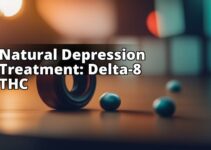What is THC-P?
– THC-P is a synthetic cannabinoid that is more potent than traditional THC.
– It interacts with the body's endocannabinoid system, producing strong psychoactive effects.
Differences between THC-P and THC
– THC-P is thought to be up to 30 times more potent than THC.
– It may have a longer duration of action and different effects on the body.
Legality of THC-P
– The legal status of THC-P varies by jurisdiction.
– It may be classified as a controlled substance or illegal in some places.
What Is THC-P?
THC-P, also known as THC max, is a novel and relatively low-profile cannabinoid that is much stronger compared to the traditional tetrahydrocannabinol (THC) and is 33% more active than delta-9 THC.
Though the research currently surrounding THC-P is limited, it is widely suggested to consume it in small doses due to its potency.
Doses of most cannabinoids, including THC, range from 1-2mg for low effects, to 5-10mg for standard effects, and 15mg for high effects. THC-P strengths in the market range from 30-100mg.
Apart from its medical and recreational uses, THC-P is believed to have more health benefits than CBD (cannabidiol).
What Is THC?
THC (Delta-9 Tetrahydrocannabinol) is the active ingredient in cannabis that is responsible for the psychoactive effects.
It functions by activating areas of the brain, producing an effect known as the high.
When THC binds to cannabinoid receptors such as CB1 and CB2, this plays a unique role on the body's endocannabinoid system – the system responsible for regulating several important physiological functions, including mood, appetite, sleep, and immune response.
On average, THC can be detected in blood tests, urine tests, and saliva tests for about a month after your last use. However, occasional consumers may only test positive for THC about five days after usage.
Furthermore, it has several therapeutic values. Research has continued to support THC's potential benefits, especially when used in correct dosages.
Key Differences Between THC and THC-P
THC and THC-P are two cannabinoids that provide different high effects, regardless of the many similarities that they have.
This chart summarizes some of their key differences:
How THC-P Works
THC and THC-P exert their effects by binding to the same CB1 cannabinoid receptors in the brain, but with different affinities.
In contrast to THC's binding affinity to THC receptors approximately 10 times lower than that of THC, THC-P's affinity for CB1 is 33% higher than THC's.
Potential Benefits of THC-P
Limited research shows that THC-P has several potential therapeutic properties that could benefit an individual's health, such as:
Appetite Stimulation
THC-P can stimulate appetite, as it binds to the CB1 receptors located in the gastrointestinal tract and brain. This interaction elicits a feeding response, leading to an increase in an individual's appetite.
Pain Relief and Management
THC-P can be just as effective as other painkillers in relieving pain. The novel CB1 receptor-stimulating compound activates brain function, which processes pain sensations.
In some studies, THC-P has demonstrated its ability to modulate the endorphin system in the body and reduce inflammation, which results in less pain. In other words, THC-P may help suppress pain response and muscle reactions.
Potential Drawbacks of THC-P
Currently, THC-P's drawbacks are still not clear due to inadequate research.
However, studies show that THC-P could be a partial agonist for CB1 receptors, promoting changes in body composition through weight gain and suppressing the analgesic properties of other CB1 agonists.
Moreover, because of its higher affinity to bind with CB1 receptors, THC-P may cause a period of intense psychoactive effects when used in high amounts.
Personal Experience: The Impact of THC-P on My Friend's Mental Health
One of the most fascinating aspects of the cannabis plant is the wide range of compounds it contains, each with its own unique effects and potential benefits. Recently, a friend of mine, Sarah, had an experience with a lesser-known cannabinoid called THC-P, which highlighted the importance of understanding the differences, effects, and legality of these compounds.
THC-P: A Mysterious Encounter
Sarah, a 30-year-old avid cannabis user, had always enjoyed the relaxing and euphoric effects of THC. However, during a visit to a dispensary, she stumbled upon a new product that claimed to contain THC-P. Intrigued, she decided to give it a try.
Unexpected Effects and Mental Health Struggles
Within minutes of consuming THC-P, Sarah began to feel an intense and overwhelming high. Unlike the familiar effects of THC, this experience was accompanied by extreme anxiety and paranoia. Sarah's heart raced, and she found it difficult to calm her racing thoughts.
Seeking Clarity: Researching THC-P
Concerned about Sarah's experience, I decided to delve deeper into the effects of THC-P. I discovered that THC-P is a highly potent cannabinoid, believed to be up to 30 times stronger than regular THC. Its unique chemical structure allows it to bind more strongly to the cannabinoid receptors in the brain, resulting in a more intense psychoactive experience.
The Legal Gray Area
As I continued my research, I also discovered that the legality of THC-P is still ambiguous in many jurisdictions. While THC is the primary psychoactive compound found in cannabis and is subject to various regulations, THC-P falls into a regulatory gray area due to its novelty and lack of widespread research.
Lessons Learned: Responsible Cannabis Use
Sarah's experience with THC-P highlighted the importance of responsible cannabis use and understanding the potential risks associated with lesser-known cannabinoids. As more research is conducted, it is crucial for individuals to educate themselves about the compounds they consume and to approach new products with caution.
Conclusion
The story of Sarah's encounter with THC-P serves as a reminder that the cannabis plant is complex, and its various compounds can have vastly different effects. By understanding the differences, effects, and legality of cannabinoids like THC-P, we can make informed decisions about our cannabis use and ensure a safe and enjoyable experience.
Is THC-P Legal?
The main challenge when it comes to the legal status of THC-P is that it is relatively unknown. The 2018 Farm Bill classified all cannabinoids derived from hemp except for delta-9 THC as Schedule 5(5) substances.
In contrast, the Controlled Substance Act considers THC and THC-P to be Schedule 1 narcotics.
Research is needed to understand the potential effects of emerging compounds such as THC-P fully.
Final Thoughts
THC-P is a novel and potent synthetic cannabinoid with effects similar to traditional THC but potentially more pronounced.
Little is currently known about this compound's safety profile, but research suggests that it is much stronger and requires smaller doses than traditional THC.
The endocannabinoid system (ECS) is at the center of THC-P's interactions with the body. While the cannabinoid receptor can bind well with both THC and THC-P, the way these compounds activate the receptors is completely different from each other.
THC-P is more likely to bind with the CB1 receptor compared to THC, and at a higher potency. They produce an intense effect when used, causing noticeable side effects on an individual's mood, sleep, attention, and cognition.
Given its profile, THC has been considered illegal and potentially dangerous. Limited information is preventing THCP from being recognized in public consciousness as a carry-over from THC speculation.
Keep in mind that THC is not entirely dangerous. In some cases, such as mitigating the symptoms of glaucoma and multiple sclerosis, the usual dose of THC is the one recommended.
However, as with any substance you ingest, it is crucial to be aware of the potential downsides and take appropriate precautions.
Consulting with an experienced healthcare professional will help with this.
FAQ
Q. What is THC-P and how does it differ from THC?
A. THC-P is a rare and potent cannabinoid, more powerful than THC, known for its psychoactive effects.
Q. Who discovered THC-P and when?
A. THC-P was discovered by researchers in Italy in 2019 during a study on cannabis compounds.
Q. What are the potential benefits of THC-P?
A. THC-P may have potential therapeutic benefits such as pain relief, appetite stimulation, and anti-inflammatory properties.
Q. How does THC-P interact with the body's endocannabinoid system?
A. THC-P binds to the CB1 receptors in the brain and nervous system, producing its psychoactive effects.
Q. What are the concerns about THC-P's potency and effects?
A. Some concerns about THC-P include its potential for causing stronger psychoactive effects and the need for further research on its long-term effects.
Q. How is THC-P different from other cannabinoids like CBD?
A. Unlike CBD, THC-P is a psychoactive cannabinoid that can induce a high, while CBD has no psychoactive effects.
Dr. Jessica Miller is a renowned expert in the field of cannabinoids and their effects on mental health. With a PhD in Neuroscience from Harvard University, she has dedicated her career to researching the impact of various cannabinoids on the brain and behavior. Dr. Miller has published numerous peer-reviewed articles in prestigious scientific journals, shedding light on the therapeutic potential and risks associated with cannabis use.
Throughout her career, Dr. Miller has conducted extensive research on THC (delta-9-tetrahydrocannabinol) and its effects on mental health. Her groundbreaking studies have provided valuable insights into the neurobiological mechanisms underlying the psychoactive properties of THC and its potential benefits for conditions such as chronic pain, anxiety, and depression.
Recognizing the need for a responsible and evidence-based approach to cannabis use, Dr. Miller has also explored the emerging field of THC-P (tetrahydrocannabiphorol). Her latest research delves into the key differences between THC and THC-P, their effects on the endocannabinoid system, and the potential benefits and drawbacks of THC-P.
With her expertise and dedication to advancing our understanding of cannabinoids, Dr. Miller is a trusted voice in the scientific community and aims to provide accurate and reliable information to help individuals make informed decisions about cannabis use.




